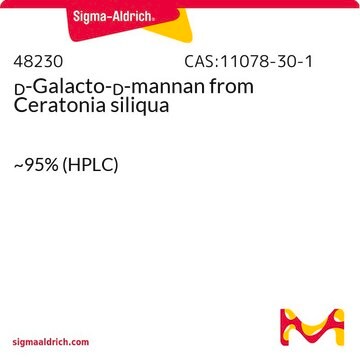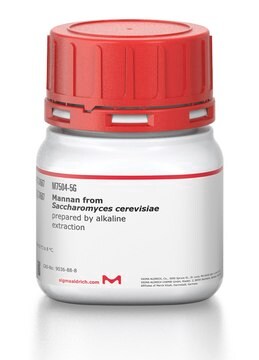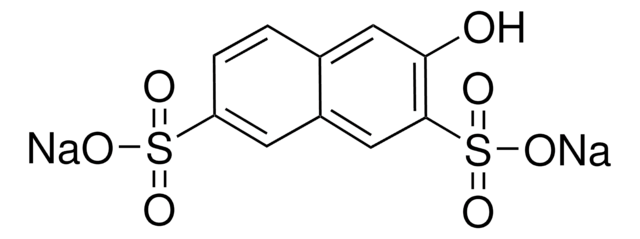G0753
Locust bean gum from Ceratonia siliqua seeds
Synonym(s):
Galactomannan polysaccharide, Gum, locust bean, Manno-galactan (main component)
Sign Into View Organizational & Contract Pricing
All Photos(2)
About This Item
Recommended Products
Application
Locust bean gum (LBG, galactomannan polysaccharide) from Ceratonia siliqua seeds may be used as a substrate to help identify, differentiate and characterize mannanase(s), such as the β-Mannanases (EC 3.2.1.78). LBG may be used in the development of drug delivery devices. LBG may be used to study its properties as a protective agent on both eucalyptus and microcrystalline cellulose destruction of crystallinity by ball milling. LBG may be used to study its properties as a food additive that reduces spoilage caused by Aspergillus flavus. LBG may be used as a starting material for the organic synthesis of hyperbranched N-glycan core structures.
Other Notes
Believed to be a straight chain polymer of mannose with one galactose branch on every fourth mannose and a M.W. of approx. 310 kDa.
To gain a comprehensive understanding of our extensive range of Oligosaccharides for your research, we encourage you to visit our Carbohydrates Category page.
Storage Class Code
11 - Combustible Solids
WGK
WGK 2
Flash Point(F)
Not applicable
Flash Point(C)
Not applicable
Personal Protective Equipment
dust mask type N95 (US), Eyeshields, Gloves
Choose from one of the most recent versions:
Certificates of Analysis (COA)
Lot/Batch Number
Don't see the Right Version?
If you require a particular version, you can look up a specific certificate by the Lot or Batch number.
Already Own This Product?
Find documentation for the products that you have recently purchased in the Document Library.
Customers Also Viewed
Camila P Favaro et al.
Biomolecules, 10(2) (2020-02-09)
Soluble coffee offers the combined benefits of high added value and practicality for its consumers. The hydrolysis of coffee polysaccharides by the biochemical route, using enzymes, is an eco-friendly and sustainable way to improve the quality of this product, while
T Mohammadi Moghaddam et al.
Journal of the science of food and agriculture, 91(6), 1083-1088 (2011-02-11)
Lallemantia royleana (Balangu) is a mucilaginous endemic plant which is grown in different regions of world. The flow behaviour of Balangu seed extract (BSE) and its mixture with xanthan, guar and locust bean gums at 1:3, 1:1 and 3:1 ratios
B M Smith et al.
Journal of food science, 77(6), C684-C689 (2012-06-08)
Carob germ proteins have been shown to have functional properties similar to wheat gluten enabling formulation and production of yeast leavened gluten-free baked goods from a true dough rather than a stiff batter. The purpose of this research was to
Hossein Vaheed et al.
Journal of industrial microbiology & biotechnology, 38(1), 101-111 (2010-09-08)
In this research, ethanol production from carob pod extract (extract) using Zymomonas mobilis with medium optimized by Plackett-Burman (P-B) and response surface methodologies (RSM) was studied. Z. mobilis was recognized as useful for ethanol production from carob pod extract. The
S Sánchez-Segado et al.
Bioresource technology, 104, 324-328 (2011-11-22)
A process for the production of ethanol from carob (Ceratonia siliqua) pods was designed and an economic analysis was carried out for a hypothetical plant. The plant was assumed to perform an aqueous extraction of sugars from the pods followed
Our team of scientists has experience in all areas of research including Life Science, Material Science, Chemical Synthesis, Chromatography, Analytical and many others.
Contact Technical Service










